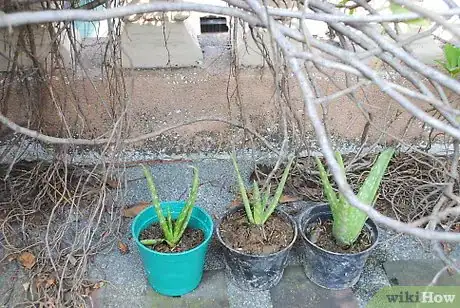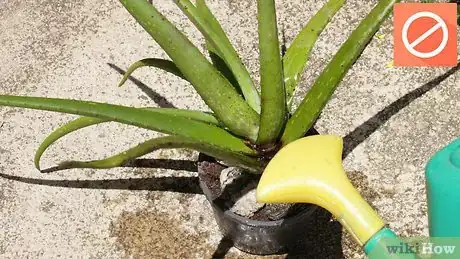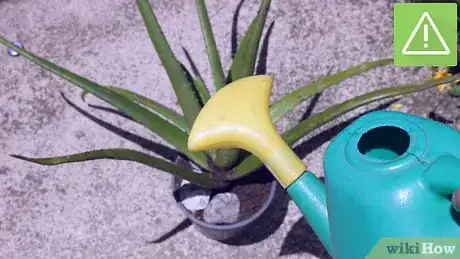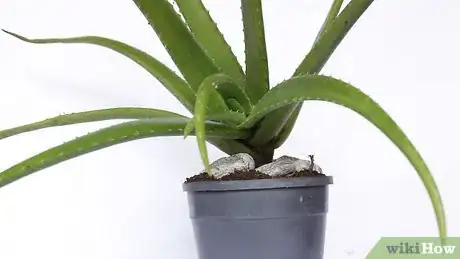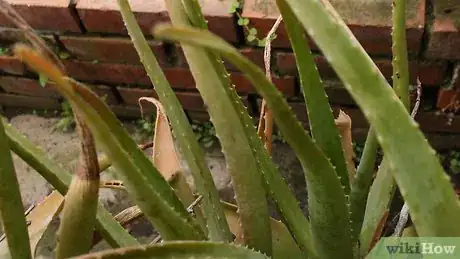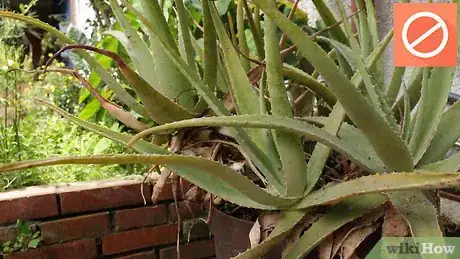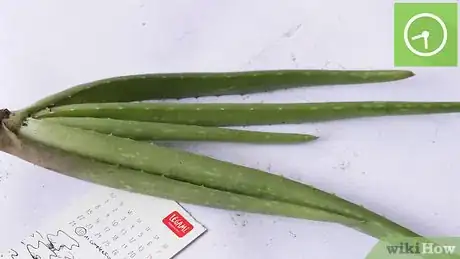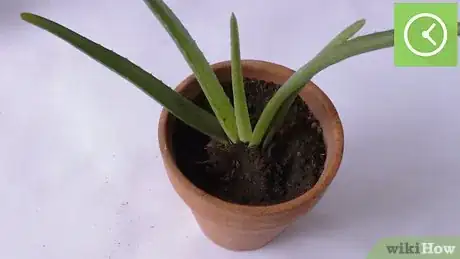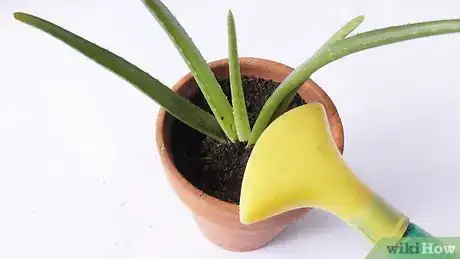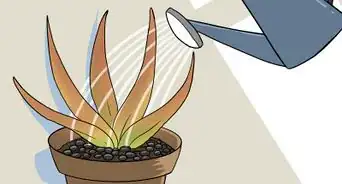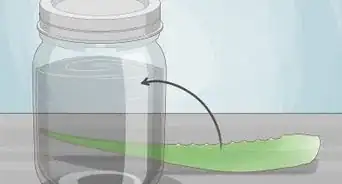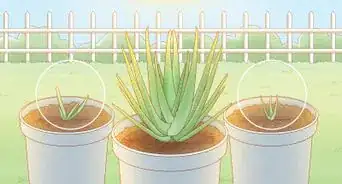This article was co-authored by Andrew Carberry, MPH. Andrew Carberry is a Food Systems Expert and the Senior Program Associate at the Wallace Centere at Winrock International in Little Rock, Arkansas. He has worked in food systems since 2008 and has experience working on farm-to-school projects, food safety programs, and working with local and state coalitions in Arkansas. He is a graduate of the College of William and Mary and holds a Masters degree in public health and nutrition from the University of Tennessee.
There are 8 references cited in this article, which can be found at the bottom of the page.
wikiHow marks an article as reader-approved once it receives enough positive feedback. This article received 41 testimonials and 92% of readers who voted found it helpful, earning it our reader-approved status.
This article has been viewed 933,231 times.
Aloe vera is both popular and easy to grow, provided you understand the level of water and sun that mimics the hot climate this plant thrives in. Unusually for a succulent, the aloe plant cannot be grown from a leaf cutting, and instead is typically propagated by detaching younger clone plants from the base of the adult plant or from the joint root system. These young plants must be treated carefully, as explained in detail in the section on propagation.
Steps
Planting or Transplanting Aloe Vera
-
1Know when to transplant. Aloe plants have relatively short roots and heavy leaves, so they are commonly moved to a heavier pot when they become top-heavy and tip over. If Aloe vera runs out of space for its roots to grow, it may start to produce "pups" that can be moved to their own pot (see the Propagating section). If you are more interested in the adult plant growing than producing new plants, transplant it to a larger pot before the roots begin to circle the walls of its container.[1]
- If you wish to transplant a young plant growing at the base of an older one, see the Propagating section instead.
-
2Give the plant adequate sunlight and warmth. Aloe vera plants prefer 8–10 hours of sunlight a day.[2] While they grow best in warm or hot temperatures, they are capable of surviving cooler seasons in a more dormant state. However, they may suffer harm if exposed to temperatures below 25ºF (-4ºC).
- Hardiness zones 9, 10, and 11 are most suitable for keeping Aloe vera outdoors year round. If you live in another zone, you may wish to keep your Aloe vera outdoors most of the year, and bring it indoors before the frost.
- The sunniest windows are those facing west or south if you live in the northern hemisphere, or those facing west or north if you live in the southern hemisphere.
- Despite the plant's adaptations that allow it to thrive in hot conditions, it is still possible to burn the plant. Move it to an area of light shade if the leaves begin to turn brown.[3]
Advertisement -
3Plant the Aloe vera in well draining soil. Aloe vera plants are adapted for survival in dry conditions, and may rot if planted in soil that collects standing water. Use a cactus potting mix, or create your own mix using equal parts soil, sand, and gravel.[4]
- If planting Aloe vera in a container, make sure the container has a hole in the base for water to drain through.
-
4Cover the root ball when planting but do not let the leaves touch the soil. Place the Aloe vera root ball just below the soil surface. If any of the thick, green leaves are partially buried or touch the soil, they may rot.
-
5Cover the surface of the soil with gravel or pebbles (optional). Place a layer of small rocks around the base of the aloe plant to keep the soil in place and reduce evaporation.[5] This is not required for your aloe plant to thrive, so you may leave the soil exposed if you prefer the appearance.
- White stones will reflect warmth from the sun to the base of the plant, which can be a good idea if you do not live in a hot climate.[6]
-
6Do not water for the first few days after planting. Before you start watering, give the aloe plant a few days to repair any roots that may have been damaged during planting.[7] . Watering damaged roots increases the chance of root rot. Aloe plants store plenty of water in their leaves, and should not be harmed by the lack of water during this time. Give it a light watering the first one or two times you water if you would like to be extra safe.
- For watering instructions in day to day care, see Providing Daily Care.
Providing Daily Care and Troubleshooting
-
1Water whenever the soil is dry during the growing season. During summer, or any time the weather is warm and sunny, aloe plants will grow fastest with regular watering. However, it is much easier to overwater aloe plants than to dry them out, so do not water until the soil has dried out to a depth of 3 inches (7.5 cm).
-
2Water infrequently during the cold season. Aloe plants often go dormant during winter, or when the weather is cold for a prolonged period of time. Unless you are keeping them in a heated room year round, you should only water them once or twice a month during this period.[8]
-
3Fertilize once a year or never. Aloe plants do not require fertilizer, and overuse can harm the plant or cause it to grow in an unhealthy manner. If you wish to encourage growth, use a low nitrogen, high phosphorous, low potassium fertilizer, such as a 10:40:10 or 15:30:15. Apply once a year in late spring, at the start of the growing season.[9]
-
4Clear weeds carefully. The soil around the aloe plant should be free of grass and weeds. Remove these regularly if the plant is outdoors, but do so carefully. Because good aloe soil is loose and sandy, it is easy to damage the roots with vigorous weed-pulling.[10]
-
5Increase sunlight if the leaves look flat and low. If the leaves are growing flat and low, increase sunlight. Aloe vera leaves should grow upward or outward at an angle, toward the sunlight. If they are low to the ground or growing flat outward, the plant is probably not receiving enough sun.[11] Move it to a sunnier area. If it is indoors, consider keeping it outdoors during daylight hours.
-
6Decrease sunlight if the leaves turn brown. If the leaves turn brown, decrease sunlight. While aloe is hardier than most plants when it comes to sun exposure, it is still possible to burn the leaves. If the aloe plant turns brown, move it to an area that receives shade during the early afternoon.
-
7Increase water if the leaves look thin/curled. If the leaves are thin and curled, increase water. The thick, fleshy leaves store water that the plant uses in times of drought. If the leaves are looking thin or curling, water the aloe plant more frequently.[12] Be careful not to overcompensate: water should drain quickly through the soil to prevent root rot, which is difficult to stop.
-
8Stop watering if the leaves turn yellow or fall apart. Yellowed or "melting" leaves are suffering due to excess water. Stop watering altogether for the next week (or two weeks during the dormant season), and water less frequently once you resume. You may remove any discolored leaves from the plant without much chance of harm, although it is best to use a disinfected knife.
Propagating New Plants
-
1Let your adult aloe plant grow to fill its container. While any healthy aloe plant has a chance to produce younger plants, or "pups", this is most likely to happen when the adult plant has reached the boundaries of its container.[13]
-
2Wait until young plants emerge. Your Aloe vera plant should start to produce "pups", which are clones of itself that share some of the mother plant's root system and may be attached to the base as well. These will sometimes grow out of the drainage hole of the container, or even from roots snaking over to neighboring containers![14]
- Pups tend to be a lighter green than the adult plant's leaves, and when first emerging do not have the same spiny leaf edges as the adult.[15]
-
3Let the young plants grow to sufficient size. The young plants will do best if you wait until they are a little larger and mature enough to have a few roots of their own. While this size varies with subspecies and individual plants, a good rule of thumb is that the young plant should be at least 3 inches (7.5 cm) tall, and preferably 5 inches (12.5 cm).[16] If the container has sufficient space, wait until the young plant is 1/5 the size of the adult and has several sets of "true leaves" that look like the adult's.[17]
-
4Use a sharp, clean knife to remove the young plant. Sanitize your knife first to reduce the chance of infection. Clear away the dirt at the base of the pup to see whether it is attached to the mother plant. If it is, cut it away, making sure to keep the young plant attached to its roots if any are present. The presence of its own roots will increase the odds of success, but they may not be easy to find before you remove the pup.
-
5Leave cut plants in the air for a couple days. Instead of planting the new aloe immediately, you may wish to allow the plant to form a callus over the knife cut. Placing the cut surface of the plant directly against soil increases the odds of infection.
-
6Plant in its own container and support. Place the young plant on top of well-draining soil, without burying the leaves. Because the root system is likely to be small (or even nonexistent), you may need to prop up the plant with a layer of pebbles and lean it against another object. The root system should grow large enough to support the plant within a few weeks.[18]
- More detailed information can be found in the Planting section, which applies to young plants as well as mature ones.
-
7Mist once every few days if the plant has no roots. Before the roots have grown in, do not water the plant. Wait at least a couple weeks for a pup to grow its own roots before watering it. Instead, mist the plant with a spray bottle once every three days.[19]
-
8Water sparingly after roots set in. Aloe plants can last a long time without water, and if you water the plant before its roots are extensive enough, the water could pool and rot the plant.[20] If the pup already has its own root system, you may instead get the roots to set by giving it one watering and leaving it in the shade for 2 to 3 weeks.
-
9Care for as an adult plant to keep it fresh. Once the plant is in its container and has grown roots, it can be treated as an adult plant. Follow the instructions in the section on Providing Daily Care.
Expert Q&A
-
QuestionIs it necessary to remove the pups from the adult plant, or could I leave them with the mother plants?
 Andrew Carberry, MPHAndrew Carberry is a Food Systems Expert and the Senior Program Associate at the Wallace Centere at Winrock International in Little Rock, Arkansas. He has worked in food systems since 2008 and has experience working on farm-to-school projects, food safety programs, and working with local and state coalitions in Arkansas. He is a graduate of the College of William and Mary and holds a Masters degree in public health and nutrition from the University of Tennessee.
Andrew Carberry, MPHAndrew Carberry is a Food Systems Expert and the Senior Program Associate at the Wallace Centere at Winrock International in Little Rock, Arkansas. He has worked in food systems since 2008 and has experience working on farm-to-school projects, food safety programs, and working with local and state coalitions in Arkansas. He is a graduate of the College of William and Mary and holds a Masters degree in public health and nutrition from the University of Tennessee.
Food Systems Expert The pups do not have to be separated from the adult plant. Instead, the plant should be re-potted in a larger pot to give the roots room to grow.
The pups do not have to be separated from the adult plant. Instead, the plant should be re-potted in a larger pot to give the roots room to grow.
Warnings
- Unlike many plants in the succulent family, Aloe vera cannot be grown from a leaf cutting. You must instead use the younger, separate plant attached to the main plant, preferably with its own roots system and several shoots.[22]⧼thumbs_response⧽
Things You'll Need
- Aloe vera seeds, cutting, or adult plant
- Clay pot
- Water
- Cactus potting mix, or a homemade mix of sand, gravel, and soil.
References
- ↑ http://www.aloeplant.info/treat-your-aloe-as-you-would-like-your-aloe-to-treat-you/
- ↑ http://www.howtogrowstuff.com/how-to-grow-aloe-vera/
- ↑ http://www.aloeplant.info/treat-your-aloe-as-you-would-like-your-aloe-to-treat-you/
- ↑ http://faq.gardenweb.com/faq/lists/cacti/2000073249017614.html
- ↑ http://faq.gardenweb.com/faq/lists/cacti/2000073249017614.html
- ↑ http://www.howtogrowstuff.com/how-to-grow-aloe-vera/
- ↑ http://faq.gardenweb.com/faq/lists/cacti/2000073249017614.html
- ↑ http://faq.gardenweb.com/faq/lists/cacti/2000073249017614.html
- ↑ http://www.howtogrowstuff.com/how-to-grow-aloe-vera/
- ↑ http://www.howtogrowstuff.com/how-to-grow-aloe-vera/
- ↑ http://www.aloeplant.info/treat-your-aloe-as-you-would-like-your-aloe-to-treat-you/
- ↑ http://www.aloeplant.info/treat-your-aloe-as-you-would-like-your-aloe-to-treat-you/
- ↑ http://www.aloeplant.info/treat-your-aloe-as-you-would-like-your-aloe-to-treat-you/
- ↑ http://www.balconycontainergardening.com/index.php/plants/123-propagate-aloe-vera
- ↑ http://www.gardenista.com/posts/diy-how-to-propagate-aloe-vera-the-plant-of-immortality
- ↑ http://www.balconycontainergardening.com/index.php/plants/123-propagate-aloe-vera
- ↑ http://www.gardeningknowhow.com/houseplants/aloe-vera/aloe-plant-propagation.htm
- ↑ http://faq.gardenweb.com/faq/lists/cacti/2000073249017614.html
- ↑ http://faq.gardenweb.com/faq/lists/cacti/2000073249017614.html
- ↑ http://faq.gardenweb.com/faq/lists/cacti/2000073249017614.html
- ↑ http://davesgarden.com/guides/articles/view/3380/
- ↑ http://www.aloeplant.info/how-to-propagate-your-aloe-vera-plant/
About This Article
If you want to plant aloe vera, find a warm location where the plant will receive 8-10 hours of light a day. Use a cactus potting mix or create your own using equal parts soil, sand, and gravel, ensuring that the soil does not hold standing water. When you plant the aloe vera, cover the root ball with soil but do not let the green leaves touch the soil or they may rot. Do not water the aloe vera for a few days after planting. To learn more about what to do if the leaves change colors or start to wilt, keep reading!
